Aerospace manufacturing is a high technology industry that produces aircraft, guided missiles, space vehicles, aircraft engines.
Read more ...

A fixed-wing aircraft is an aircraft capable of flight using forward motion that generates lift as the wing moves through the air.
Fixed-wing aircraft are distinct from rotary-wing aircraft in which wings rotate about a fixed mast and ornithopters in which lift is generated by flapping wings.
A powered fixed-wing aircraft that is propelled forward by thrust from a jet engine or propeller is typically called an aeroplane, aeroplane, or simply plane. Other types of powered fixed-wing aircraft include powered paragliders and ground effect vehicles. Unpowered fixed-wing aircraft, including gliders, paragliders, hang gliders and kites, can use rising air to gain height.
Most fixed-wing aircraft are flown by a pilot on board the aircraft, but some are designed to be remotely or computer-controlled.
First attested in English in the late 19th century, the word aeroplane derives from the French aéroplane, which comes from the Greek ??? (a? r), "air" + ?????? (plans), "wandering". An ancient Greek term coined from these two words was ?????????? (aeroplanes), "wandering in the air".
In the United Kingdom and most of the Commonwealth, the term "aeroplane" is used. In the United States, the term "aeroplane" is applied to these aircraft. The form "aeroplane" is the older of the two, dating back to the mid- to late-19th century. The spelling "aeroplane" was first recorded in 1907.
Many stories from antiquity involve flight, such as the Greek legend of Icarus and Daedalus, and the Vimana in ancient Indian epics. Around 400 BC in Greece, Archytas was reputed to have designed and built the first artificial, self-propelled flying device, a bird-shaped model propelled by a jet of what was probably steam, said to have flown some 200 m. This machine may have been suspended for its flight.
Some of the earliest recorded attempts with gliders were those by the 9th-century poet Abbas Ibn Firnas and the 11th-century monk Eilmer of Malmesbury; both experiments injured their pilots. Leonardo da Vinci researched the wing design of birds and designed a man-powered aircraft in his Codex on the Flight of Birds (1502).
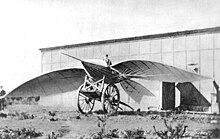
In 1799, Sir George Cayley set forth the concept of the modern aeroplane as a fixed-wing flying machine with separate systems for lift, propulsion, and control. Cayley was building and flying models of fixed-wing aircraft as early as 1803, and he built a successful passenger-carrying glider in 1853. In 1856, Frenchman Jean-Marie Le Bris made the first powered flight, by having his glider "L'Albatros artificial" pulled by a horse on a beach. In 1883, the American John J. Montgomery made a controlled flight in a glider. Other aviators who made similar flights at that time were Otto Lilienthal, Percy Pilcher, and Octave Chanute.
Sir Hiram Maxim built a craft that weighed 3.5 tonnes, with a 110-foot (34-meter) wingspan that was powered by two 360-horsepower (270-kW) steam engines driving two propellers. In 1894, his machine was tested with overhead rails to prevent it from rising. The test showed that it had enough lift to take off. The craft was uncontrollable, which Maxim, it is presumed, realised because he subsequently abandoned work on it.
In the 1890s, Lawrence Hargrave conducted research on wing structures and developed a box kite that lifted the weight of a man. His box kite designs were widely adopted and became the prevalent type of aircraft until 1909. Although he also developed a type of rotary aircraft engine, he did not create and fly a powered fixed-wing aircraft.
The Wright brothers flights in 1903 are recognised by the Fédération Aéronautique Internationale (FAI), the standard setting and record-keeping body for aeronautics, as "the first sustained and controlled heavier-than-air powered flight". By 1905, the Wright Flyer III was capable of fully controllable, stable flight for substantial periods.
In 1906, Alberto Santos-Dumont made what has been claimed as the first aeroplane flight unassisted by catapult and set the first world record recognised by the Aéro-Club de France by flying 220 metres (720 ft) in less than 22 seconds. This flight was also certified by the FAI.
An early aircraft design that brought together the modern monoplane tractor configuration was the Bleriot VIII design of 1908. It had movable tail surfaces controlling both yaw and pitch, a form of roll control supplied either by wing warping or by ailerons and controlled by its pilot with a joystick and rudder bar. It was an important predecessor of his later Bleriot XI Channel-crossing aircraft of the summer of 1909.
World War I served as a testbed for the use of the aircraft as a weapon. Initially seen by the generals as a "toy", aircraft demonstrated their potential as mobile observation platforms, then proved themselves to be machines of war capable of causing casualties to the enemy. The earliest known aerial victory with a synchronised machine gun-armed fighter aircraft occurred in 1915, by German Luftstreitkräfte Leutnant Kurt Wintgens. Fighter aces appeared; the greatest (by a number of air victories) was Manfred von Richthofen.
Following WWI, aircraft technology continued to develop. Alcock and Brown crossed the Atlantic non-stop for the first time in 1919. The first commercial flights took place between the United States and Canada in 1919.
Aircraft had a presence in all the major battles of World War II. They were an essential component of the military strategies of the period, such as the German Blitzkrieg or the American and Japanese aircraft carrier campaigns of the Pacific.
The first jet aircraft was the German Heinkel He 178, which was tested in 1939. In 1943, the Messerschmitt Me 262, the first jet fighter aircraft, went into service in the German Luftwaffe. In October 1947, the Bell X-1 was the first aircraft to exceed the speed of sound.
In 1948-49, aircraft transported supplies during the Berlin Blockade. New aircraft types, such as the B-52, were produced during the Cold War.
The first jet airliner, the de Havilland Comet, was introduced in 1952. The Boeing 707, the first widely successful commercial jet, was in commercial service for more than 50 years, from 1958 to 2010. The Boeing 747 was the world's biggest passenger aircraft from 1970 until it was surpassed by the Airbus A380 in 2005.

The most common configuration of a fixed-wing aircraft includes:



Most aircraft are largely symmetrical along a plane of symmetry.
Some aircraft operate with different configurations. An aircraft may have two or more fuselages, or additional pods or booms. Some aircraft have more than one horizontal or vertical stabiliser, while V-tail aircraft combine the horizontal and vertical stabilisers into a pair of diagonal surfaces.
A flying wing aircraft has no discernible fuselage structure and horizontal or vertical stabilisers, though it may have small blisters or pods. The opposite of this is a lifting body which has no wings, though it may have small stabilising and control surfaces.
A number of controls allow pilots to direct aircraft in the air. The controls found in a typical fixed-wing aircraft are as follows:
Other controls can include:
The controls may allow full or partial automation of flight, such as an autopilot, a wing leveller, or a flight management system. Pilots adjust these controls to select a specific attitude or mode of flight, and then the associated automation maintains that attitude or mode until the pilot disables the automation or changes the settings. In general, the larger and/or more complex the aircraft, the greater the amount of automation available to pilots.
On an aircraft with a pilot and copilot, or instructor and trainee, the aircraft is made capable of control without the crew changing seats. The most common arrangement is two complete sets of controls, one for each of two pilots sitting side by side, but in some aircraft (military fighter aircraft, some taildraggers and aerobatic aircraft) the dual sets of controls are arranged one in front of the other (in tandem). A few of the less important controls may not be present in both positions, and one position is usually intended for the pilot in command (e.g., the left "captain's seat" in jet airliners). Some small aircraft use controls that can be moved from one position to another, such as a single yoke that can be swung into position in front of either the left-seat pilot or the right-seat pilot (e.g., Beechcraft Bonanza).
Aircraft that require more than one pilot usually have controls and displays intended to suit each pilot position, but still with sufficient duplication so that any of the pilots can fly the aircraft alone in an emergency. For example, in jet airliners, the controls on the left (captain's) side include both the basic controls and those normally manipulated by the pilot in command, such as the tiller, whereas those of the right (first officer's) side include the basic controls again and those normally manipulated by the copilot, such as flap levers. The unduplicated controls that are required for flight are positioned so that they can be reached by either pilot, but they are often designed to be more convenient to the pilot who manipulates them under normal conditions.
An unmanned aircraft is controlled remotely or via means such as gyroscopes or other forms of autonomous control.
Instruments provide information to the pilot and the co-pilot. Flight instruments provide information about the aircraft's speed, direction, altitude, and orientation. Powerplant instruments provide information about the status of the aircraft's engines and APU. Systems instruments provide information about the aircraft's other systems, such as fuel delivery, electrical, and pressurisation. Navigation and communication instruments include all the aircraft's radios. Instruments may operate mechanically or electrically, requiring 12VDC, 24VDC, or 400 Hz power systems. An aircraft that uses computerised CRT or LCD displays almost exclusively is said to have a glass cockpit.
Basic instruments include:
Other instruments might include:
Most aircraft are constructed by companies with the objective of producing them in quantity for customers. The design and planning process, including safety tests, can last up to four years for small turboprops, and up to 12 years for aircraft with the capacity of the A380.
During this process, the objectives and design specifications of the aircraft are established. First, the construction company uses drawings and equations, simulations, wind tunnel tests and experience to predict the behaviour of the aircraft. Computers are used by companies to draw, plan and do initial simulations of the aircraft. Small models and mockups of all or certain parts of the aircraft are then tested in wind tunnels to verify the aerodynamics of the aircraft.
When the design has passed through these processes, the company constructs a limited number of these aircraft for testing on the ground. Representatives from an aviation governing agency often make the first flight. The flight tests continue until the aircraft has fulfilled all the requirements. Then, the governing public agency of aviation of the country authorises the company to begin production of the aircraft.
In the United States, this agency is the Federal Aviation Administration (FAA), and in the European Union, Joint Aviation Authorities (JAA). In Canada, the public agency in charge and authorising the mass production of aircraft is Transport Canada.
In the case of the international sales of aircraft, a license from the public agency of aviation or transports of the country where the aircraft is also to be used is necessary. For example, aircraft from Airbus need to be certified by the FAA to be flown in the United States and vice versa, aircraft of Boeing need to be approved by the JAA to be flown in the European Union.
Quieter aircraft are becoming more and more needed due to the increase in air traffic, particularly over urban areas, as aircraft noise pollution is a major concern.
Small aircraft can be designed and constructed by amateurs as a home built. Other homebuilt aircraft can be assembled using pre-manufactured kits of parts that can be assembled into a basic aircraft and must then be completed by the builder.
There are few companies that produce aircraft on a large scale. However, the production of an aircraft for one company is a process that actually involves dozens, or even hundreds, of other companies and plants, that produce the parts that go into the aircraft. For example, one company can be responsible for the production of the landing gear, while another one is responsible for the radar. The production of such parts is not limited to the same city or country; in the case of large aircraft manufacturing companies, such parts can come from all over the world.
The parts are sent to the main plant of the aircraft company, where the production line is located. In the case of large aircraft, production lines dedicated to the assembly of certain parts of the aircraft can exist, especially the wings and the fuselage.
When complete, an aircraft is rigorously inspected to search for imperfections and defects. After approval by inspectors, the aircraft is put through a series of flight tests to assure that all systems are working correctly and that the aircraft handles properly. Upon passing these tests, the aircraft is ready to receive the "final touchups" (internal configuration, painting, etc.), and is then ready for the customer.
When the risk is measured by deaths per passenger kilometre, air travel is approximately 10 times safer than travel by bus or rail. However, when using the deaths per journey statistic, air travel is significantly more dangerous than a car, rail, or bus travel. Air travel insurance is relatively expensive for this reason- insurers generally use the deaths per journey statistic. There is a significant difference between the safety of airliners and that of smaller private aircraft, with the per-mile statistic indicating that the former is 8.3 times safer than the latter.

A monoplane is a fixed-wing aircraft with one main set of wing surfaces, in contrast to a biplane or triplane. Since the late 1930s, it has been the most common form of a fixed-wing aircraft.
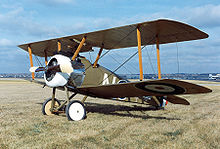
A biplane is a fixed-wing aircraft with two superimposed main wings. The Wright brothers' Wright Flyer used a biplane design, as did most aircraft in the early years of aviation. While a biplane wing structure has a structural advantage, it produces more drag than a similar monoplane wing. Improved structural techniques and materials and the need for greater speed made the biplane configuration obsolete for most purposes by the late 1930s.
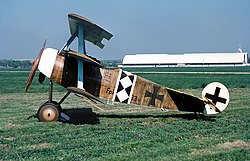
A triplane is a fixed-wing aircraft equipped with three vertically-stacked wing planes. Tailplanes and canard foreplanes are not normally included in this count, although they may occasionally be. As with biplanes, this type is obsolete.
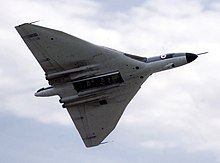
The delta wing is a wing planform in the form of a triangle. It is named for its similarity in shape to the Greek uppercase letter delta (?).
Delta wings are mainly used for transonic and supersonic aircraft, the swept wing avoids the shockwave from impinging on the wing.

In aeronautics, canard (French for "duck") is an airframe configuration of fixed-wing aircraft in which the forward surface is smaller than the rearward, the former being known as the "canard", while the latter is the main wing. In contrast, a conventional aircraft has a small horizontal stabiliser behind the main wing.

Variable geometry aircraft are 'fixed wing' aircraft where the wing configuration can be changed in flight.
A variable-sweep wing is an aeroplane wing that may be swept back and then returned to its original position during flight. It allows the aircraft's platform to be modified in flight and is, therefore, an example of a variable geometry aircraft.
Variable camber wings, variable-incidence wings, and oblique wings
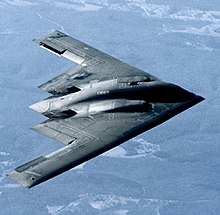
A flying wing is a tailless fixed-wing aircraft which has no definite fuselage, with most of the crew, payload and equipment being housed inside the main wing structure.
A flying wing may have various small protuberances such as pods, nacelles, blisters, booms, vertical stabilisers (tail fins), or undercarriage. Some aircraft have no fuselage but do have a separate horizontal stabiliser surface mounted on one or more booms; these are also commonly referred to as flying wings, although this is not strictly correct. An example of such a design is the Northrop X216H.
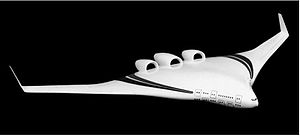

Blended Wing Body aircraft have a flattened and airfoil shaped body, which produces most of the lift to keep itself aloft, and distinct and separate wing structures, though the wings are smoothly blended in with the body.
Thus BWB incorporates design features from both a futuristic fuselage and flying wing design. The purported advantages of the BWB approach are efficient high-lift wings and a wide airfoil-shaped body. This enables the entire craft to contribute to lifting generation with the result of potentially increased fuel economy.
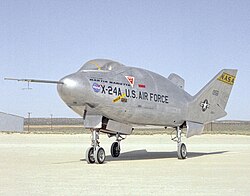
The Martin Aircraft Company X-24 built as part of a 1963 to 1975 experimental US military program |
|
|
A lifting body is a fixed-wing aircraft configuration in which the body itself produces lift. In contrast to a flying wing, which is a wing with minimal or no conventional fuselage, a lifting body can be thought of as a fuselage with little or no conventional wing. Whereas a flying wing seeks to maximise cruise efficiency at subsonic speeds by eliminating non-lifting surfaces, lifting bodies generally minimise the drag and structure of a wing for subsonic, supersonic, and hypersonic flight, or, spacecraft re-entry. All of these flight regimes pose challenges for proper flight stability.
Lifting bodies were a major area of research in the 1960s and 70s as a means to build a small and lightweight manned spacecraft. The US built a number of famous lifting body rocket planes to test the concept, as well as several rocket-launched re-entry vehicles that were tested over the Pacific. Interest waned as the US Air Force lost interest in the manned mission, and major development ended during the Space Shuttle design process when it became clear that the highly shaped fuselages made it difficult to fit fuel tankage.
Fixed-wing aircraft can be sub-divided according to the means of propulsion they use.

Gliders are fixed-wing aircraft that are intended primarily for unpowered flight. Sailplanes, hang gliders, and paragliders are gliders used mainly for recreation. After launch, further energy is obtained through the skilful exploitation of rising air in the atmosphere. Gliders that are used for the sport of gliding have high aerodynamic efficiency. The highest lift-to-drag ratio is 70:1, though 50:1 is more common. Glider flights of thousands of kilometres at average speeds over 200 km/h have been achieved. The glider is most commonly launched by a tow-plane or by a winch. Some gliders, called motor gliders, are equipped with engines (often retractable), and some are capable of self-launching. The most numerous unpowered aircraft are hang gliders and paragliders. These are foot-launched and are in general slower, smaller, and less expensive than sailplanes. Hang gliders most often have flexible wings given shape by a frame, though some have rigid wings. Paragliders have no frames in their wings. Military gliders have been used in war to deliver assault troops, and specialised gliders have been used in atmospheric and aerodynamic research. Rocket-powered aircraft and spaceplanes have also made unpowered landings.
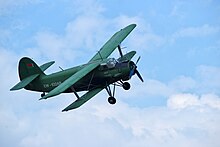
Smaller and older propeller aircraft make use of reciprocating engines that turns a propeller to create thrust. They are quieter than jet aircraft, but they fly at lower speeds and have lower load capacity compared to similar-size jet-powered aircraft. However, they are significantly cheaper and much more economical than jets, and in general, are the best option for people who need to transport a few passengers and/or small amounts of cargo. They are also the aircraft of choice for pilots who wish to own an aircraft.
Turboprop aircraft are a halfway point between propeller and jet: They use a turbine engine similar to a jet to turn propellers. These aircraft are popular with commuter and regional airlines, as they tend to be more economical on shorter journeys.
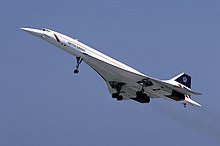
Jet aircraft use gas turbines to create thrust. These engines are much more powerful than a reciprocating engine. As a consequence, they have greater weight capacity and fly faster than propeller driven aircraft. Turbofan jet engines are less noisy than some other types, and they have seen widespread usage partly for that reason.
Most wide-body aircraft can carry hundreds of passengers and several tonnes of cargo and are able to travel for distances up to 17,000 km.
Jet aircraft possess high cruising speeds (700 to 900 km/h, or 400 to 550 mph) and high speeds for take-off and landing (150 to 250 km/h). Due to the speed needed for takeoff and landing, jet aircraft use flaps and leading-edge devices to the control of lift and speed. Many also use thrust reversers to slow down the aircraft upon landing.
Supersonic aircraft, such as military fighters, use turbines (often with afterburners), to generate the power needed for flight faster than the speed of sound. Flight at supersonic speed creates sonic booms so is in general prohibited in areas of heavier population density. Supersonic airliners (e.g. Concorde) are no longer in use.
A solar-powered aircraft generates the needed energy by means of solar cells. On 8 July 2010, the manned Solar Impulse became the first solar-powered aeroplane to fly through an entire night.
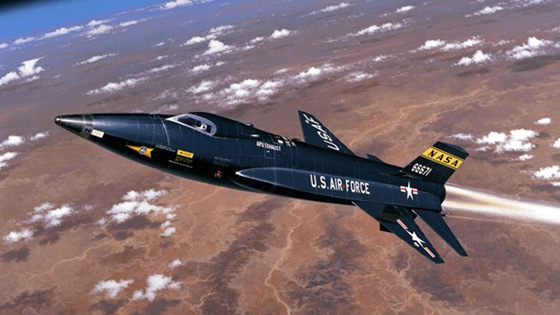
In World War II, the Germans deployed the Me 163 Komet rocket-powered aircraft. The first fixed-wing aircraft to break the sound barrier in level flight was a rocket plane – the Bell X-1. The later North American X-15 broke much speed and altitude records and laid much of the groundwork for later aircraft and spacecraft design. Rocket aircraft are not in common usage today, although rocket-assisted takeoffs are used for some military aircraft. Current rocket aircraft include the SpaceShipOne and the XCOR EZ-Rocket.

A ramjet is a form of jet engine that contains no major moving parts and can be particularly useful in applications requiring a small and simple engine for high-speed use, such as missiles. The D-21 Tagboard was a Mach 3+ reconnaissance drone that was cancelled in 1971. The SR-71's engines ran 80% as ramjets at high speeds.
Scramjet aircraft are in the experimental stage. A scramjet has a very simple engine design. It works by air being forced into one side of a tube-like engine. That air is ignited by fuel, causing it to come out hotter and faster on the other side. This engine requires high speed in order to work, but it is suitable for the speeds at which it travels. The NASA X-43 is an experimental unmanned scramjet with a world speed record for a jet-powered aircraft – Mach 9.7, nearly 12,000 kilometres per hour (7,500 mph) at an altitude of about 36,000 metres (118,000 ft). The X-43A set the flight speed record in 2004.
Aerospace manufacturing is a high technology industry that produces aircraft, guided missiles, space vehicles, aircraft engines.
Read more ...Some six centuries after Ibn Firnas, Leonardo da Vinci developed a hang glider design in which the inner parts of the wings are fixed.
Read more ...A fixed-wing aircraft is an aircraft capable of flight using forward motion that generates lift as the wing moves through the air.
Read more ...Aerospace engineering is the primary branch of engineering concerned with the design, construction and science.
Read more ...We use cookies to improve your experience on our website. By browsing this website, you agree to our use of cookies. More information.
